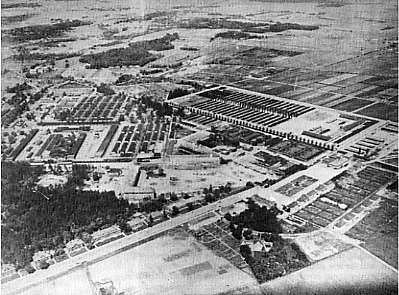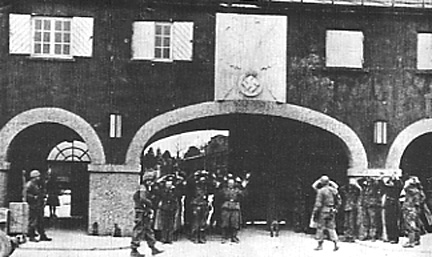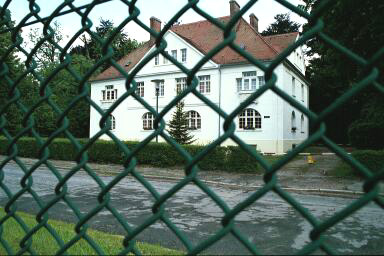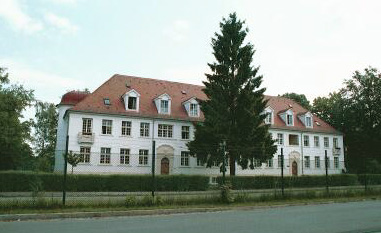The Avenue of the SS"Nearly a thousand yards from the rail siding, was the Camp itself . The approach was a wide, two-lane road with a lawn down the middle. One could imagine from the impressive massiveness of the gray (sic) Administration Buildings and Barracks, the fine lawns, great walls and black iron-grilled gates, that you were approaching a wealthy girls finishing school in the suburbs of one of our great cities. All was so neat, so orderly, so beautiful." Lt. Col. Walter J. (Mickey) Fellenz, Commanding Officer, 1st Battalion, 222nd Regiment in a report to the Commanding General of the 42nd Division of the US Seventh Army, 6 May 1945, describing the Avenue of the SS leading to the SS-Übungslager.  In the aerial photograph above, the Dachau concentration camp is the rectangular area in the center on the right-hand side. One can easily recognize the two rows of barracks buildings with dark roofs and the U-shaped administration building with the roll call rectangle in front of it. The SS Training Center and army garrison is on the left. From the left-hand corner of the bottom of the photograph, a street runs past 8 large white houses toward Eicke Plaza, which is the small rectangle to the left of the southwest corner of concentration camp. The 8 houses were built before 1920 and are still standing. These beautiful red-roofed houses face the street that was called the Avenue of the SS when the camp was in operation. On April 29, 1945, the 42nd Rainbow division of the US Seventh Army approached the Dachau concentration camp from the southwest. In order to get to the prison compound itself, they first had to go through the SS training camp. The main entrance to the SS camp was on a street called The Avenue of the SS, facing a formal plaza called Eicke Plaza. The Americans were astounded to see this beautiful street, as described by one of the liberators in his report, quoted above. When the Dachau concentration camp first opened on March 22, 1933, the prisoners were housed in the existing buildings of the Dachau Royal Gunpowder and Munitions Factory, which had been built in 1915 while World War I was in progress. The former munitions factory was a huge place and the prison compound covered only one fifth of the grounds, or an area of about five acres. In June 1936, when the Nazis decided to rebuild the concentration camp on the same site, they also made the decision to enlarge the SS training camp and garrison that had been established on the factory grounds. On July 2, 1936, the Bavarian Ministry of Finance turned over the entire factory grounds, which was state property, to the Nazis and they began construction on an enlarged SS camp with the use of prison labor. The SS camp was to be four times the size of the concentration camp, and some of the existing buildings of the former factory would be used. By 1938, the SS camp was like a small town with stores, a movie theater, a post office, restaurants, a community center, a triangular-shaped swimming pool, and an enormous area of barracks for the thousands of soldiers who were stationed there. There was also a military hospital for SS soldiers. On the day that the Dachau concentration camp was liberated, Brig. Gen. Henning Linden, Assistant Division Commander of the 42nd Rainbow Division, rode down the Avenue of the SS in his jeep as he went to meet SS 2nd Lt. Heinrich Wicker who had been persuaded by the Red Cross to surrender the concentration camp at the main gate of the complex, which faced the Eicke Plaza on the Avenue of the SS, just east of the 8 houses. The photograph below shows a group of SS soldiers surrendering to American troops at the main gate into the SS complex. This photo was taken by Raphaël Algoet, a photographer sent by the Belgian government.  The next photographs below show 3 of the 8 SS buildings on the Avenue of the SS, which are still standing. The area is now fenced off and visitors are not allowed access. These houses were used by the SS when the training camp and garrison was in operation, up until 1945. The Avenue of the SS has been renamed Strasse der KZ-Opfer, which means Street of the Concentration Camp Victims.    After the Dachau complex was liberated by the US Seventh Army on April 29, 1945, many of the SS soldiers were incarcerated in the prison compound that was formerly the concentration camp. American soldiers moved into the beautiful buildings in the SS-Übungslager and remained there for the next 28 years. The SS training camp was renamed the Eastman Barracks, and American soldiers were stationed here until 1973. The army garrison was then turned over to the Bavarian government and many of the buildings were torn down between 1978 and 1984. Gates into Dachau complexPreserved railroad tracksHistory of the SSBack to SS CampBack to Table of ContentsHome |